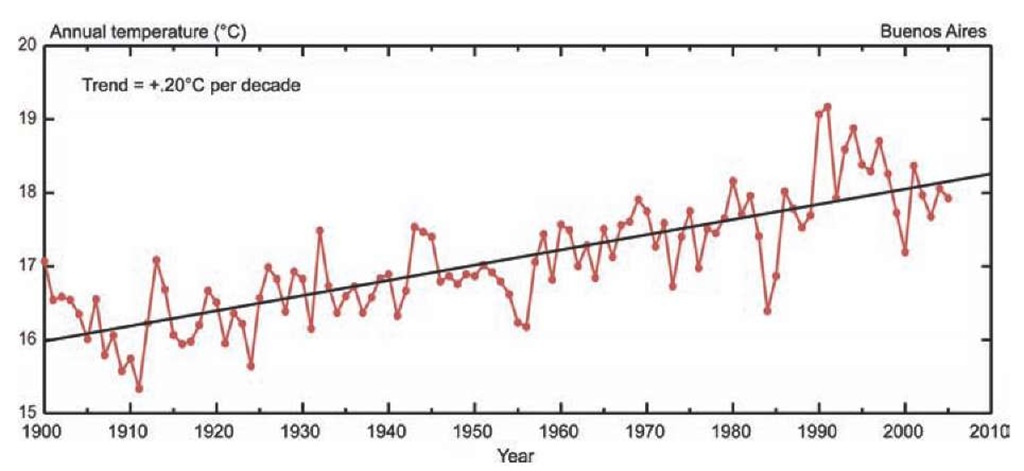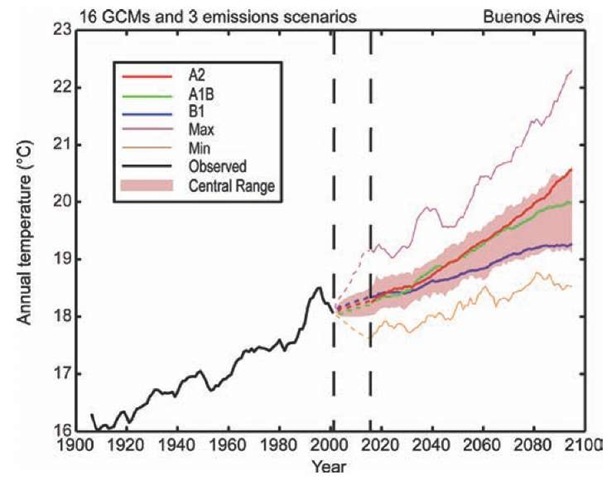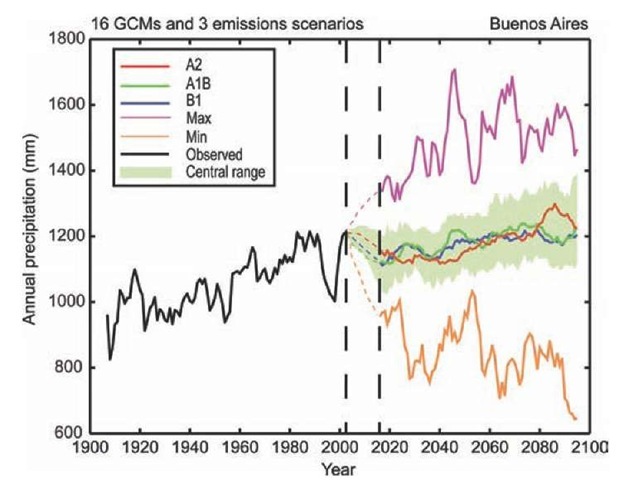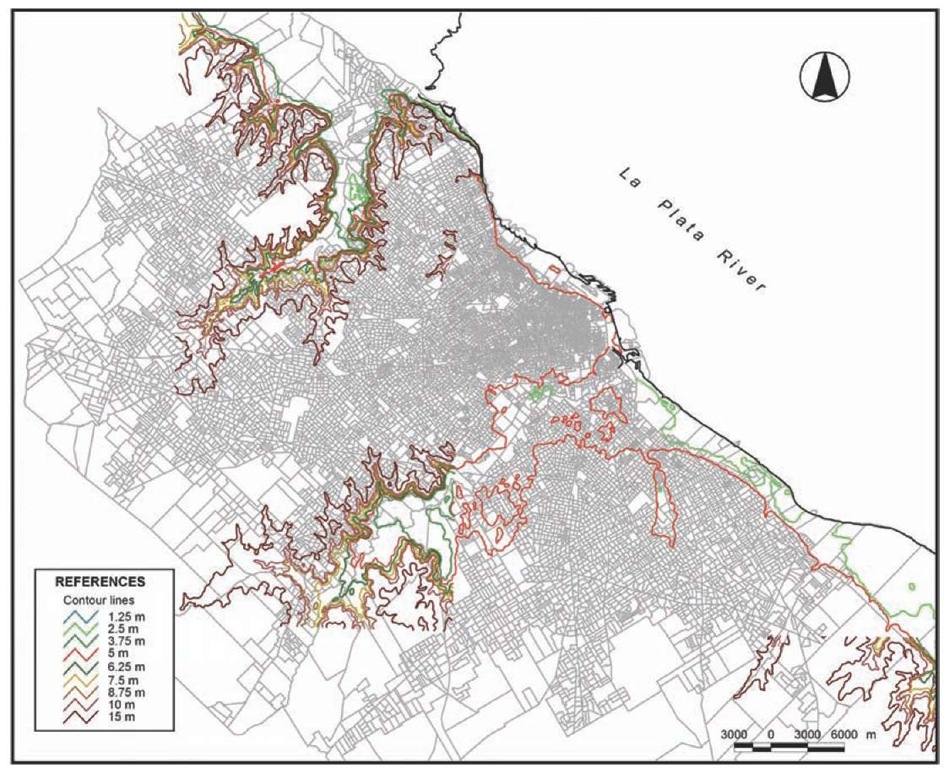We attempt to illustrate and assess the relative role of each of the three elements through a presentation of four major case studies for the metropolitan areas of Buenos Aires, Delhi, Lagos, and New York. These cities are located in four different global sub-regions and have a range of socio-economic conditions and vulnerability to climate hazards. A primary criterion for selecting these cities is that all four have leadership that is committed to addressing the issue of climate change and thus are exemplars for other cities within their respective region, and globally. Further, as these are all megacities and important national urban centers in their respective countries, not only do they constitute a significant share of the national GDP but also help to shape the direction of national urban development policies. See Table 2.1 for demographic parameters for the case study cities.
Most aspects of the risk case studies articulated in this topic are equally applicable to small and medium sized cities, as in many cases time-series data on climate parameters are available. Smaller cities may have fewer resources to apply to the development of climate risk responses and thus may have additional needs for national and international guidance and support. However, the diverse urban conditions in the case study cities allow for some generalized lessons to be drawn regarding effective and efficient urban responses to climate change. The combination of city cases allows for a comparison among developing countries as well as contrasts between developed and developing country cities, their challenges and responses.
For each city, available knowledge is analyzed for various aspects of climate risks (including uncertainty). Background information from the case study cities has been evaluated and selected variables have been assigned to the framework components. The case studies allow for the understanding of the transferability of the climate risk framework to a variety of cities and what "climate services" of data analysis, access, and processing need to be provided at the international level.
To provide concrete examples of how climate risk information can be communicated, current trends in key climate variables (including temperature, precipitation, and the incidence of extreme events) for each of the case study cities have been determined, and recent IPCC 2007 projections (up to 16 models and three emissions scenarios) have been used to create city-focused downscaled climate model projections. The degree to which these models are able to replicate observed climate and climate trends in the past several decades is described. We also explore discrepancies, if any, between the identified risks, vulnerabilities, social capacities, and the current responses of cities to climate-related hazards. This addresses the important question of real-versus-perceived needs.
Buenos Aires, Argentina
Buenos Aires is the third largest city in Latin America, and is the political and financial capital of Argentina. The city is composed of several sub-jurisdictions that were added as the city expanded since its inception in the fifteenth century as a Spanish port. The Greater Buenos Aires Agglomeration (AGBA) has over 12 million inhabitants (National Population Census, 2001), with 77 percent of the population living in the surrounding provincial boroughs, and 23 percent in the central urban core of Buenos Aires City (Instituto Nacional de Estadistica y Censos (INDEC), 2003). Buenos Aires City (CABA) is administered by an autonomous government elected directly by its citizens.
Hazards and vulnerability
Increases in sea and river levels, rising temperature and precipitation, along with increased frequency of extreme events such as flooding caused by heavy (convective) rains and storm surges, as well as droughts, are the primary climate-induced hazards for Buenos Aires.
Table 2.1: Demographics for the case study cities (metropolitan area).
|
Metropolitan area |
Population |
Area |
Population density |
Slum population as a percentage of national urban population |
|
Buenos Aires |
12.0 million |
3,833 km2 |
3,131 people per km2 |
26.2 percent |
|
Lagos |
7.9 million |
1,000 km2 |
7,941 people per km2 |
65.8 percent |
|
Delhi |
12.9 million |
9,745 km2 |
1,324 people per km2 |
34.8 percent |
|
New York |
8.2 million |
790 km2 |
10,380 people per km2 |
N/A |
Figure 2.2: Observed temperatures, Buenos Aires.
The city has a humid subtropical climate with long hot summers, and winters with low precipitation caused by the central semi-permanent high-pressure center in the South Atlantic. This pressure system can cause strong south-southeast winds in the autumn and summer causing floods along the shores (Camillioni and Barros, 2008). For details on observed and projected temperature and precipitation trends for Buenos Aires see Figures 2.2, 2.3, 2.4, and 2.5. In regard to extreme events, there is an increase in frequency of extreme precipitation and associated city floods, see Table 2.2.
Further, occurrence of precipitation events of more than 100 millimeters within 24 hours has increased from 19 times between 1911 and 1970 to 32 times between 1980 and 2000. Such observed increases in the quantity and frequency of extreme precipitation not only adversely affect urban infrastructure, but also damage private property and disrupt the economic and social functioning of the city. With respect to sea level rise and drainage, the city is located along the shores of the La Plata River and spreads over the pampa, a wide fertile plain, and adjoining the Parana river delta.
Figure 2.3: Projected temperatures, Buenos Aires.
As a result, the entire metropolitan area is less than 30 meters above mean sea level. As the city grew, several rivulets that formed the natural drainage system were replaced with a system of underground stormwater drains (Falczuk, 2008).
Spatial distribution of poor versus non-poor
Over the 1990s the city experienced sprawl, with developers building gated communities on the periphery of the metropolitan area, extending the city over an area one-and-a-half times the size of the CABA (Pirez, 2002). With disparity on the rise and migration of the non-poor from the city center to the periphery, the city has been further spatially segregated by income groups. This condition was further intensified with the economic crisis of 2001, which created the "new poor" consisting of the newly unemployed middle class.
The precise distribution and enumeration of the slums is complicated by two additional factors. First is the process of "urban invasions" whereby squatter settlements crop up sporadically across the city. Second, like all other urban data for AGBA, information on the poor is parsed into 30 administrative units. For this research, data for slums and other dilapidated housing in the CABA were derived from an Ombudsman survey in 2006 (see Table 2.3 for quantification of low-income housing), which found that about 20 percent of all households in the urban core of the AGBA live in poor housing conditions.
Additionally, the survey identified 24 new settlements with 13,000 inhabitants located under bridges or simply "under the sky" (Defensoria del Pueblo de la Ciudad de Buenos Aires, 2006). However, unlike developing-country slums, most households have land tenure and property rights related to their homes due to a well-established public housing program in Argentina. Mapping the spatial distribution of differential vulnerability of the poor and non-poor to floods and other hazards is critical to crafting a climate-risk assessment of Buenos Aires (see Figure 2.6).
Figure 2.4: Observed precipitation, Buenos Aires.
Low elevation urban areas
In its present configuration, a quarter of the metropolitan area is susceptible to floods (Clichevsky, 2002; Menendez, 2005). Urban expansion continues over the basins of the Matanza-Riachuelo, Reconquista, and Lujan rivers, as well as the estuary of the La Plata River (see Figure 2.6). These areas consist of a combination of new gated communities, real estate speculation sites, as well as illegal plots in the flood plain targeted toward the housing needs of the poor. With a lack of regulation governing such urban development and the creation of unprotected infrastructure in the flood plain, the vulnerability of this part of the city is increasing (Rios and Gonzalez, 2005).
To assess the vulnerability of the low-elevation areas of the city, a review of past urban floods was undertaken. As reported in newspapers and official assessments, floods impaired all modes of public and private transportation, including domestic flights, road, and rail; disrupted energy supplies, telephone lines, and traffic lights; flooded buildings; and created an overall disruption of city life. Streets and cellars were waterlogged and people living in low-elevation neighborhoods in the suburbs were evacuated (Gonzalez, 2005).
Figure 2.5: Projected precipitation, Buenos Aires.
In sum, the economic costs were high. Unlike urban disasters in other developing countries, the death toll in Buenos Aires related to flooding disasters tends to be low. The primary costs are the disruption of the economic activity of the city and damage to public and private property.
As the metropolitan area has been expanding into the flood plains, a simulation to quantify the population vulnerable to sea level rise was conducted. Barros et al. (2008) observed: "Assuming little change in population density and distribution, under the scenario of maximum sea-level rise during the 2070 decade [...] the number of people living in areas at flood risk with a return period of 100 years is expected to be about 900,000, almost double the present at-risk population." The potential damage to public and private assets can be assessed from a recent survey that estimated that 125 public offices, 17 social security offices, 205 health centers, 928 educational buildings, 306 recreational areas, and 1,046 private industrial complexes are currently at risk of floods.
A conservative estimate by Barros et al. (2008) is that at present the damage to real estate from floods is about US$30 million per year. Assuming a business-as-usual scenario, which includes a 1.5 percent annual growth in infrastructure and construction and no adoption of flood-protection measures, the projected annual cost of damages is US$80 and US$300 million by 2030 and 2070 respectively. These estimates do not include the losses to gated communities of the non-poor being built in the coastal area, largely located less than 4.4 meters above mean sea level.
Table 2.2: Extreme events in Buenos Aires.
|
City |
Extreme temperatures |
Extreme precipitation |
|
Buenos Aires |
January & February 1987; |
March 1988; May 2000; February 2003 |
|
December & January 1988; |
||
|
December & January 1996- |
||
|
97; January & February 2001; |
||
|
January 2002; January 2003; |
||
|
January 2004; December |
||
|
2004 |
Table 2.3: Slum population in Buenos Aires City (CABA).
|
Housing types by building quality |
Number of units |
|
Slums (villas miseria) |
< 120,000 |
|
Properties of other people (inmuebles tomados) |
200,000 |
|
Tenement house (casas de inquilinato) |
70,000 |
|
Lodges |
70,000 |
|
Rooms in relatives’ houses, rental rooms, or overcrowded houses |
120,000 |
Nor does this account for the loss in productivity of the labor force, which can be significant given the size of the population likely to be affected. Thus, the costs of not responding to climate change in the course of urban development are projected to be significant and disruptive.
Adaptive capacity: current and emerging issues
The Argentinean government’s response to global climate change has been dominated by mitigation efforts related to policies and programs to reduce greenhouse gas emissions (Pochat et al., 2006), with relatively little attention to adaptation. The lead national agency to address climate issues is the Secretariat for Environmental and Sustainable Development.
In 1993 Argentina became a signatory to the United Nations Framework Convention on Climate Change. In response, the federal government established the office for Joint Implementation, but in 1998 this was renamed the Office for Clean Development Mechanisms. Further, in 1999 Argentina adopted the objectives of the Greenhouse Gases Reduction Programme, and in 2001 signed on to the Kyoto Protocol. To institutionalize the response to climate change, in 2003 a Climate Change Unit was established within the Secretariat for Environmental and Sustainable Development. In 2007 this evolved into the Climate Change Office. In addition, the government has been supporting a range of research programs, such as the National Program on Climate Scenarios, which was initated in 2005. Through these institutional arrangements, first and second national reports were prepared in 1997 and 2006 respectively. The third version is under preparation (Pochat et al, 2006).
However, the roles and responsibilities of governmental agencies in regard to climate change remain fragmented, while adaptation responses, specifically at the city level, remain to be addressed. In addition, four ministries with a dozen departments and institutions are involved in flood monitoring and broader disaster management systems (Natenzon and Viand, 2008).
Figure 2.6: Low-elevation land and land parcels in Buenos Aires.
Gradually, lower levels of government such as the states and local authorities are taking an interest in addressing climate change mitigation and adaptation, and a range of stakeholders such as NGOs, the media, and citizen groups are participating.
Conflicting plans and multiple jurisdictions reduce the efficacy of climate change response plans at the city level as well (Murgida and Gonzalez, 2005). For example, in 2007 an Office for Climatic Protection and Energy Efficiency was established within the Ministry for Environment of Buenos Aires City. With the arrival of a new administration in December 2007 this ministry was restructured into the Ministry of Environment and Public Space, with a new Environmental Protection Agency. The Office for Climatic Protection and Energy Efficiency was dismantled despite the fact that previously initiated programs and projects such as "Clean Production" and "Air Quality" continue to be implemented (Murgida, 2007).
The primary obstacles to institutional action at the metropolitan level are lack of actionable climate information, as well as vertical and horizontal fragmentation of jurisdictions with divergent interests and responses. Administrative units within the AGBA address flood management but lack an integrated strategy. For example, within Buenos Aires City two different plans – the Urban Environmental Plan and the Buenos Aires 2015 Strategic Plan – are being implemented simultaneously but with a lack of effective coordination. Further, in practice there are two critical legislative instruments to regulate urban development in the city – namely, the Building Code enacted in 1944 and the Urban Planning Code enacted in 1977. These are complemented by additional measures such as the Flood Control Plan, and post-2001 flood tax rebates for affected communities. However, these plans, codes and norms are inconsistent. For instance, the Urban Planning Code incentivizes the occupation of vulnerable low-lying areas within the city contradicting the flood prevention plans (Gonzalez, 2005).
Moreover, constantly changing organizational roles and responsibilities of government agencies tasked to address climate change pose a challenge. For instance, in 2005 the Buenos Aires State Government created a unit to address climate change within the provincial Ministry for Environmental Policy. This office continues to be operational under the new local government that was elected in 2007, but the unit has been moved to the Ministry of Social Development and has a reduced mandate. This lack of action orientation is compounded by a general lack of public awareness of the risks associated with climate change (Assessment of Impacts and Adaptation to Climate Change, 2005).
Additionally, there is a mismatch in terms and scales. While the climate adaptation strategies such as flood prevention and management need to take a long-term view and plan for the metropolitan region as a whole, most planning interventions address short-term needs and do not take a citywide view (Murgida and Natenzon, 2007). "By analyzing who participated in the planning process and in which areas they did so, it becomes evident that the vast majority of interventions were partial, some were very specific, and a few encompass different areas and spheres" (Pirez, 2008). These issues become further complicated for the metropolitan region due to the overlap and aggregation of administrative units that lack a central governing authority.
The community of scientists and researchers has taken on an unusual task of coordinating climate-related programs and policies. A leading example of this effort was the launch of the Global Climate Change Research Program at Buenos Aires University (PIUBACC) in May 2007. The objective of this program is to map and link all research as well as city development projects within the metropolitan area so as to provide the government, civil society, and more-specifically interested groups directly involved in climate change programs with a holistic and scientific assessment of climate change risks. Additionally, the scientists are drawing transferable lessons from community knowledge on flood management along the La Plata River coast with a dual focus on the vulnerability of the poor and on adaptation to storm-surge floods (Barros et al., 2005).





